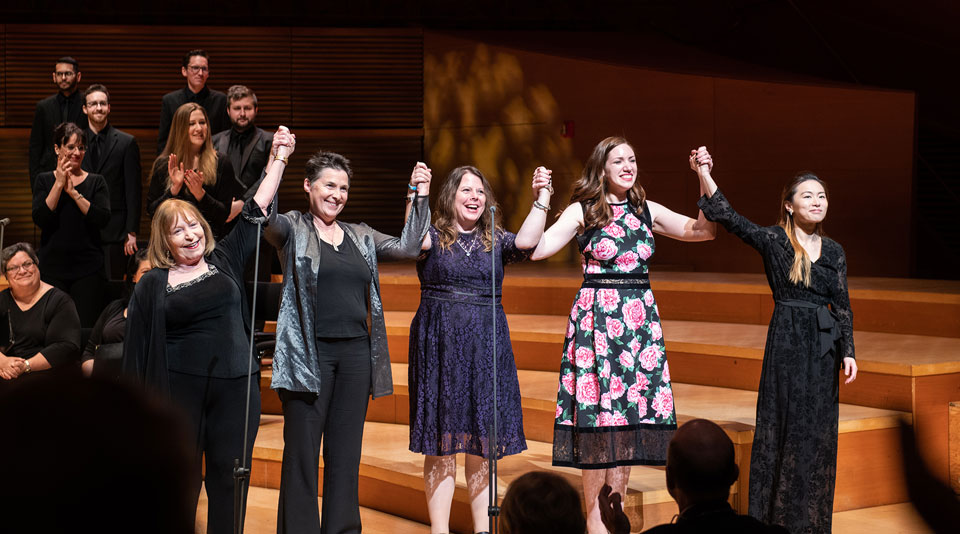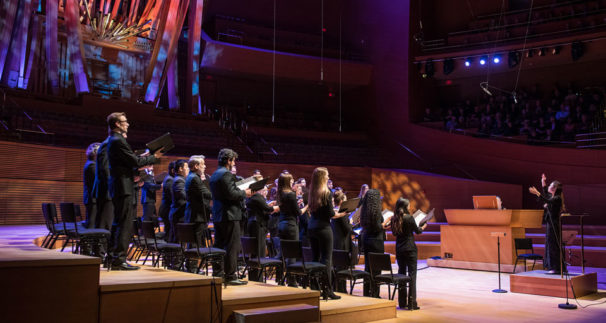
LOS ANGELES—When we think of a requiem we think of a Roman Catholic Mass for the repose of the souls of the dead. The Latin word “requiem” means “rest,” as in “requiescat in pace,” or “rest in peace” (RIP).
Nonreligious folk, too, want their loved ones to RIP, so an extended meaning of the word “requiem” can be an act or token of remembrance, as in “The children’s playroom at the local hospital endowed by Mrs. Eunice Goodwin served as a requiem for her beloved son Jonathan.”
Requiem can also refer specifically to a musical composition using familiar church texts about death, judgment, mercy, redemption, heaven, etc., sung in memory of the departed or, if the piece is impressive enough, in a concert-hall setting divorced from any particular person’s death. The sublime Mozart Requiem, for example, which he left incomplete at the time of his death at 35, is one of the pinnacles of the Western musical canon. (What we hear as the complete composition was realized by Mozart’s student Franz Xaver Süssmayr, although there have been later versions as well.) For many composers the creation of a requiem can be a career milestone.
The myth of Orpheus tells us that when he lost his wife Eurydice he went on with his lyre composing music in her honor and memory. So there is ample precedent for this kind of musical tribute and it doesn’t have to be religious. This is good news for those who grieve, yet do not feel comfortable relying on “sacred” language for comfort.
“As artists, we often talk about and perform works that deal with grief,” observes Jenny Wong, the Los Angeles Master Chorale’s associate conductor, interviewed by Thomas May for an article in the concert program for a Los Angeles Master Chorale (LAMC) performance on March 17 that included two large works. “I think that if you present a piece that deals with grief and with direct, raw emotions—with texts that speak so directly to people—you have a responsibility to be aware of where you are leading the audience emotionally.”
The two works performed on March 17 were the French composer Maurice Duruflé’s postwar Requiem dating from 1947, and a modern work for chorus in eight parts, based on texts by three women poets, called How To Go On. Its composer is the Los Angeles resident, up-and-coming figure in the musical world, Dale Trumbore, who spoke at a pre-concert panel with the poets and conductor, hosted by radio programmer Alan Chapman (sporting a jaunty head of green hair for St. Patrick’s Day).
Trumbore explained, “I’d wanted to write a requiem for a long time but I knew for me it had to be a secular requiem.” She began writing it in 2015 as “an alternative version of what comfort, hope or strength could sound like.” She aimed “to make peace with the notion of my own mortality.”
It’s almost as if the concert described an arc from the world of the churchgoing believer to the modern seeker of nontheistic spirituality.
There is actually a great deal more that esthetically conjoins these two musical monuments. Duruflé (1902-86) at the age of ten began attending the musical conservatory at the Rouen Cathedral, where they revered the tradition of Gregorian chant. That music, intoned by monks, recited scriptural texts in a kind of unison speech-song that did not follow imposed time signatures such as 2/4, 3/4, 4/4 or 6/8. What dictated the rhythm of the chant was simply the natural stresses of the words being sung—no oom-pah-pah oom-pah-pah for those guys. Duruflé’s serene Requiem is a 20th-century reinvention of chant that compensates in expressive prosody and impressionistic harmonies for the customary cadenzas and strophic forms of the Classical and Romantic eras. It was designed as a new-sounding work with deep grounding in the old—chant still giving primacy of place to the words.
In setting her texts, Trumbore takes her prosody (the way in which words are set to music) one step further. Also rhythmically free and given to irregular time signatures—“My piece changes meter every bar,” she says—Trumbore uses words sometimes as abstract sounds. She announces her process right at the beginning with repeated words and notes that function both for their concrete meaning and purely for sonic effect.
The Duruflé Requiem is one of only ten or a dozen compositions that he ever published, and it remains the principal one by which he is remembered. The LAMC has performed it before, as it is considered one of the bedrock choral compositions of the 20th century, but not since 2005. Jenny Wong conducted from memory.
It’s worth underlining that this is a post-Holocaust work. Its relative absence of bombast and ebullient gloriousness reflects a profoundly restrained sobriety, perhaps even a sense of shame and guilt at the failure of Christian religion, alongside other foundational institutions of Western civilization, to derail the Nazi machine before it created so much damage. Could an artist celebrate and praise God uncritically in 1947? The chorus rarely rises to full volume.
Duruflé’s fifth movement, “Pie Jesu,” says (in Latin), “Pious Lord Jesus, give them rest.” The dead of World War II, and in particular Jesus’s fellow Jews, might have looked askance at God wondering where he was hiding all that time as they were sent prematurely and by the indiscriminate millions to an eternal repose they never sought. Was that indeed God’s will?—one of the piercing theological questions of all time.
“This Requiem is not an ethereal work singing of detachment from human concerns,” Maurice Duruflé observed. “In the unchanging form of Christian prayer, it reflects the anguish of humanity faced with the mystery of its final end.”

The Kyrie, movement two, asks God to provide eternal deliverance “which once thou did promise to Abraham and his descendants.”
The Duruflé Requiem exists in several formats, including an arrangement for full orchestra. This iteration gave us accompaniment by Disney Hall’s magnificent organ, played with a stunning range of sound by Namhee Han. In the Sanctus, movement four, another woman instrumentalist, Cécilia Tsan, came on stage with her cello. Forty-eight singers dressed in black (half men and half women) sang from their scores. In the world of classical music so traditionally dominated by men it was refreshing to see women as conductor and instrumentalists.
A complete performance of the Duruflé Requiem can be heard here.
How To Go On
If a 1947 Requiem offers an uneasy accommodation with death, do we approach the subject differently today? That was the project to which Dale Trumbore (b. 1987) applied herself in her daring a cappella setting of texts by poets Barbara Crooker, Amy Fleury and Laura Foley. Except for her insistence on the placement of the final movement, Trumbore allows the conductor for any given performance to arrange the other movements as s/he chooses.
“While there are no exact allusions to the Latin Requiem Mass texts and it is less grounded in the afterlife,” Trumbore explains, “the piece draws on those overall themes: concern with what happens after we die and what we cannot know. As a whole, it grapples with the prospect of confronting our own mortality in the face of our grief over a loved one’s death, the weight of all that.”
As she was choosing poems to set—not having the handy, oft-recycled ecclesiastical passages to fall back on—“The first thing I noticed was that I chose texts that alternate between first person and second person and third. I liked the idea of alternating between questions and more straightforward suggestions.”
Wong opened with Barbara Crooker’s challenge, “How can we go on, knowing the end of the story?” which is the entire text of that movement. (See How for a link to the Choral Arts Initiative recording of this number.) Trumbore has her chorus chant the word “How” over and over in dusty, opaque, shifting harmonies, almost as if she were asking them to “howl” in rage and despair after a devastating diagnosis.
In “To See It,” Laura Foley suggests that “We need to separate to see the life we’ve made,” “to leave our house where someone waits for us” in order to finally, fully appreciate “our life lit from inside.” Perhaps only in quiet reflection, apart from quotidian familiarity, can we remember, and be remembered for all we meant.
Try to leave self-judgment behind as you prepare your exit, says Laura Davies Foley, the chorus pealing high soprano harmonies like train whistles that grab your ears and won’t let go:
However difficult you think it might be,
it is yours, this life,
even the failures
are yours,
even the garden, though it be unkempt,
is yours.
The same poet imagines how “Sometimes Peace Comes”:
Sometimes peace is like this:
endless and gentle and soft
and no compulsion to go
anywhere. And even the fire
you walked through,
even the trail of ashes
is gone, not even a memory
in your heart,
and even the sun is still,
unmoving and quiet,
and you have stepped into
a place beyond time,
beyond sadness and form.
A wide, high plain
where in the endless, deep silence
you find out what it is,
what it is,
and your part in it.
Trumbore uses long, sustained harmonies that sound like the “lost chords” that forever eluded us in this earthly life.
In “Requiescat,” a secular way of saying “rest in peace,” Crooker says it’s okay to let go:
Let go, let go of your family, their story
hasn’t been told, yours is already written,
let go of the world, its sweetness and sorrow,
let go of your friends, we will cry, yes,
but we will not forget you, let go,
let go your fierce will and stubbornness,
it served you well, now let it go,
your courage will remain, let your daughters
become women, your husband lie in his bed of pain,
your long journey is over, theirs is beginning….
Upon which, in an unusual gesture of repetition, Trumbore gives us again Crooker’s “How can we go on, knowing the end of the story?” verse that Wong used to begin with, but in a different musical setting and a different title, “Knowing the End.” Now that we are already familiar with the text, the composer casts this movement in more essentially choral terms, with words virtually abstracted from their meaning, as though the objective of language itself has at the end transcended the conscious mind.
Foley’s “Relinquishment” is Wong’s choice for the penultimate number, a meditation on the approaching farewell to existence. She uses the metaphor of darkness as a symbol of the end of life, but as I read it, the poem could also serve as a poem of mourning for those who are going blind and must “learn again” relying on their precious memory of sight:
I am looking at pale blue ponds of melted ice
on a frozen river
and in them perfect clouds passing.
Wind sends ripples along the water
and trees cut sharp lines into the sky. Soon
it will be gone, all of it
and I will be sitting in darkness,
sitting by a dark window, glad
for having seen this earth,
her elegant grace,
how she turns away from the sun.
And I will be learning, again,
how to give it all up by simply turning.
How to give it up to darkness, all you love. All of it.
How to give it up again and again.
Amy Fleury’s “When at Last” anchors the secular requiem at the conclusion: “Everything that comes before is moving toward this last movement,” Trumbore says. For her there is no certain paradise (“In Paradisum” is Duruflé’s concluding movement, the conviction of a true believer), but rather an unending and ultimately reassuring cycle of life.
When at last I join the democracy of dirt,
a tussock earthed over and grass healed,
I’ll gladly conspire in my own diminishment.
Let a pink peony bloom from my chest
and may it be visited by a charm of bees,
who will then carry the talcum of pollen
and nectar of clover to the grove where they hive.
Let the honey they make be broken
from its comb, and release from its golden hold,
onto some animal tongue, my soul.
Wong held her hands up when this movement concluded, and the audience kept its respectful pensive silence for what seemed like a full two minutes before she ever so glacially lowered her arms to allow the impact of this extraordinary music to settle in. The ensuing applause was ecstatic. What a journey we had experienced!
Humanists are always on the lookout for appropriately nontheistic readings and songs for ceremonial occasions, and several of these poems are certainly worthy of consideration, though Trumbore’s complex choral setting which only a professional-level ensemble can master rules it out for everyday use.
Overall, though there were soloists throughout the piece which created some tonal variety, I did find her harmonic language and textures, her pacing and her frequent use of high sustained pitches (to keep the unaccompanied singers on key?) somewhat of a predictable combination of compositional tics, actually in a manner recalling the Duruflé piece we heard earlier. Still, it is an impressive entry into the modern choral repertoire, conceived as a requiem for freethinkers, that I believe even open-minded church groups that have well prepared choirs could adopt—for churchgoers also ask these same questions of life, suffer the same grieving, and are not always soothed by formulaic reassurances of paradise.
The final bows, with an all-women cast of conductor, composer and the three poets, seemed like a fitting tribute to Women’s History Month!










